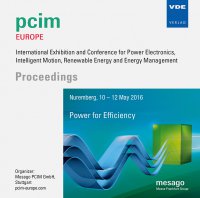Novel Technique to Reduce Substrate Tilt & Improve Bondline Control between AlN Substrate and AlSiC Baseplate in IGBT Modules
Conference: PCIM Europe 2016 - International Exhibition and Conference for Power Electronics, Intelligent Motion, Renewable Energy and Energy Management
05/10/2016 - 05/12/2016 at Nürnberg, Deutschland
Proceedings: PCIM Europe 2016
Pages: 8Language: englishTyp: PDF
Personal VDE Members are entitled to a 10% discount on this title
Authors:
Booth, James; Mumby-Croft, Paul; Packwood, Matthew; Evans, Kim; Dai, Andy (Dynex Semiconductor Ltd. UK)
Vijay, Karthik (Indium Corporation, UK)
Abstract:
Bondline control, that is the use of spacers or standoffs applied to a power module’s baseplate to achieve a homogenous solder layer, is a well understood technology employed by most power semiconductor manufacturers. It is understood that an inhomogeneous solder layer can lead to early device failure caused by cracking and delamination of the solder during thermal cycling, and that spacer technology such as stitched wirebonds for AlSiC baseplates or stamped ‘bumps’ on copper baseplates can inhibit this behaviour and increase joint lifetime. This paper presents a novel alternative method of achieving bondline control on AlSiC baseplates whilst offering a drop in solution with no additional manufacturing steps or capital investment costs; a solder preform engineered with an embedded metal mesh across the area of the preform. Samples were made to evaluate the thermal fatigue resistance of this technology in comparison to both the traditional wirebond method and samples made without any bondline control. Active metal braze Cu-AlN-Cu substrates were soldered to 140x70mm AlSiC baseplates for these trials with each bondline variant. The samples were then temperature cycled at a DeltaT of 200K, and analysed by scanning acoustic microscopy every 200 cycles. Cracking and solder layer delamination was observed at 600 cycles for the samples without bondline control and at 800 cycles for the samples with Al wirebonds; no signs of thermal fatigue was witnessed on the samples with the embedded metal mesh. The embedded metal mesh samples showed the least co-planarity deviation and superior reliability results to the Al wirebond method with the added advantage of no additional process steps.


